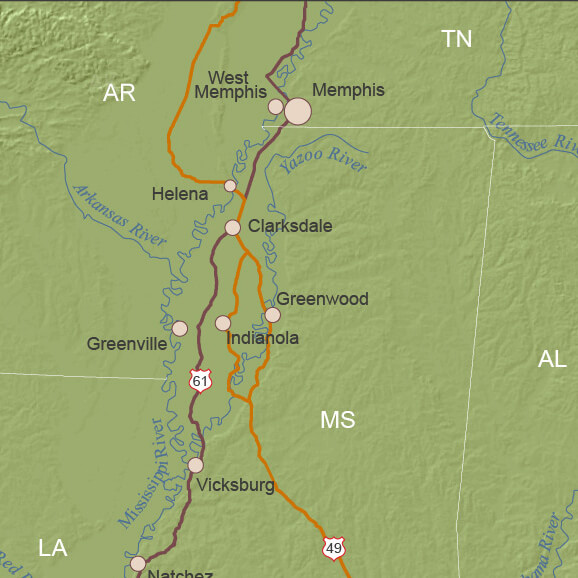Overview
Mikko Saikku reviews Christine A. Klein and Sandra B. Zellmer's Mississippi River Tragedies: A Century of Unnatural Disaster (New York: New York University Press, 2014).
Review
 |
The present system of flood control in the Mississippi Valley is a compromise resulting from a long and complicated interplay among interest groups. The current solution to the problem of floodplain settlement strives to balance widely conflicting views on economy, politics, engineering, and the environment, but satisfies only few and faces an uncertain future. In this ambitious, entertaining, but somewhat uneven book, law professors Christine A. Klein and Sandra B. Zellmer combine environmental and legal history in their examination of the relationship between human action and disaster in the Mississippi drainage basin.
Flooding, of course, has always posed a physical threat to human subsistence in the lower-lying parts of the immense watershed that drains some 40 percent of the continental United States. From their arrival on the banks of North America's greatest river and its tributaries, European and American settlers realized that economic development in the flood-prone region would be in direct proportion to the amount of control gained over the hydrological system. It was the relief from flooding—a natural phenomenon of the floodplain—that made the development of agriculture, infrastructure, and industry possible in the alluvial lowlands of the Mississippi Basin.
Reviewing generations of attempts at Mississippi River flood control, Klein and Zellmer show that the enormous task of walling the river off from its floodplain demands investments on a scale unavailable to any individual landowner, county, or state. Governmental involvement in flood control and water resource development in the Mississippi Valley evolved during the nineteenth and twentieth centuries with far-reaching effects on the floodplain's hydrological regime.
In the beginning, the riparian landowners assumed responsibility for the burden of flood control. As the inadequacy of this approach for successful prevention of overflows became evident, state and federal governments began to assume more control. Beginning with Robert W. Harrison, numerous scholars have documented how the subsequent history of water management in the Mississippi Valley shifted the burden to local and state governments and, in the end, to the federal authorities—and US taxpayers. Klein and Zellmer summarize much of this previous research and provide their own analysis on landmark judicial cases. As the economic importance of the floodplain grew with agricultural expansion, the region's largest landowners succeeded in persuading Congress to facilitate development on the alluvial floodplain with investments in flood control structures. Federal participation did not come easy, and representatives of riverside interests had to lobby hard in order to gain legal justification and congressional support for flood control.
 |
| Mississippi River Flood of 1927 showing Flooded Areas and Field of Operations, 1927. Coast and Geodetic Survey. From Records of the Coast and Geodetic Survey, RG 23. |
For more than a century the federal government has—through its participation in flood control—shaped the agricultural, industrial, and urban development of the Mississippi Valley. Federal involvement came slowly, as levee building and other flood control activities were originally perceived to profit too narrow an interest group to justify the enormous investments required. As scholars have documented, however, since the disastrous flood of 1927 ample federal funding has enabled massive human-induced change in the hydrology of the Mississippi and its tributaries.
In response to the great flood of 1927, Congress passed legislation authorizing structural control of flooding along the Mississippi and its tributaries. The Flood Control Acts of 1928, 1936, and 1938 affirmed flood control as a federal activity, and the vast Mississippi River and Tributaries (MR&T) project commenced in the Lower Mississippi Valley in 1941. Numerous additional flood-control acts have authorized "corrective" works along the river and its tributaries, including new levees for containing flood flows and floodways for the swift passage of excess flows.
After generations of work and investments, limits remain to the amount of high water that can be safely transported through the Mississippi Valley. As the Mississippi floods of 1973, 1993, and 2011—and in 2005, Hurricane Katrina—have demonstrated, the potential for serious flooding still exists despite the remaking of the Mississippi's hydrological system at an enormous economic and environmental cost. Especially the disastrous collapse of New Orleans levees in 2005 after a storm surge has cast serious doubts over the reliability of the whole flood control system.
The US Army Corps of Engineers continues to claim that "[t]he MR&T project represents one of mankind's most successful civil works projects and one of the wisest investments." 1U.S. Army Corps of Engineers, Mississippi Valley Division, "Mississippi River and Tributaries Project," http://www.mvd.usace.army.mil/About/MississippiRiverCommission%28MRC%29/MississippiRiverTributariesProject%28MRT%29.aspx. Many disagree and argue that by altering the natural hydrological regime and boosting development on the flood-prone areas, federal flood control measures have—with taxpayers' aid—caused many of the "natural" disasters along the Mississippi and created unprecedented potential for even worse havoc.
Somewhat mistitled, Mississippi River Tragedies: A Century of Unnatural Disaster is above all a wide-ranging and readable legal history "of how law reflects and even amplifies our ambivalent attitude toward nature—simultaneously revering wild rivers and places for what they are, while working feverishly to change them into something else" (front cover flap). Outlining the enormous human-induced change along the Mississippi is a formidable task, but Klein and Zellmer unveil some of the complex interactions between humans and nature along the river. On the other hand, their legal history approach necessitates the inclusion of many complicated landmark cases from different parts of the country that, while intriguing and important, originally had little direct connection to the Mississippi River. While the authors pay attention to the concept of natural disaster and social, economic, and environmental history of the Mississippi basin, their main interest clearly lies in law's agency in floodplain development.
Klein and Zellmer have a personal relationship with the Mississippi, especially with the upper portions of the river, and Mississippi River Tragedies begins with family reminiscences. The first five chapters chart the historical problems of floodplain settlement and growing federal involvement. The authors add little that is new here, except for their competent analysis of relevant legal cases and their implementation on the federal level.2The bibliography contains most of the expected studies of river development in the United States, but excludes some important work pertaining to the Lower Mississippi River. Maybe most surprising is the omission of highly relevant monographs by Pete Daniel, Robert W. Harrison, and Martin Reuss. For example, Klein and Zellmer are able to demonstrate how "misguided federal policies actually discouraged people from leaving riverfront lands, even after the areas had been designated as official floodways for the storage of excess flows" (78). The chapters on 1965's Hurricane Betsy and the Flood of 1993 illuminate events and cases that had lasting legal repercussions for Mississippi floodplain development. Hurricane Katrina and the concept of environmental justice receive their own, rather conventional chapters. At the book's end, Klein and Zellmer make a powerful argument for more sustainable floodplain use, claiming that "[w]e have wasted more than a century pursuing a foolish idea: the floodless floodplain." Now "[i]t's time to try something different: giving rivers room to flood" (203).
Mississippi River Tragedies is by no means a comprehensive appraisal of the human development of the Mississippi basin, but the authors compellingly illustrate the importance of their approach. Americans, of course, have always "improved" nature for the benefit of agriculture and commerce within the existing legal framework. Environmental and social historians too often overlook the judicial basis for the development of natural resources. And while it is impossible for the shortish (some two hundred pages) book to answer all the important questions it raises, Mississippi River Tragedies makes a convincing case for the importance of including law in the historical study of environmental change. Accessibly written, this book is an entertaining introduction to the complex history of the Mississippi during the twentieth century. 
About the Author
Mikko Saikku is currently a fellow at the Collegium for Advanced Studies, University of Helsinki in Finland. His research interests include North American environmental history and the history and culture of the US South. His publications include This Delta, This Land: An Environmental History of the Yazoo-Mississippi Floodplain, and Encountering the Past in Nature: Essays in Environmental History (with Timo Myllyntaus).
Recommended Resources
Text
Barry, John M. Rising Tide: The Great Mississippi Flood of 1927 and How It Changed America. New York: Simon and Schuster, 1997.
Colten, Craig E. An Unnatural Metropolis: Wresting New Orleans from Nature. Baton Rouge: Louisiana State University Press, 2005.
Daniel, Pete. Deep'n as It Come: The 1927 Mississippi River Flood. New York: Oxford University Press, 1977.
Harrison, Robert W. Alluvial Empire: A Study of State and Local Efforts toward Land Development in the Alluvial Valley of the Lower Mississippi River, Including Flood Control, Land Drainage, Land Clearing, Land Forming. Little Rock: Pioneer Press, 1961.
Kelman, Ari. A River and Its City: The Nature of Landscape in New Orleans. Berkeley: University of California Press, 2003.
Morris, Christopher. The Big Muddy: An Environmental History of the Mississippi and Its Peoples from Hernando de Soto to Hurricane Katrina. New York: Oxford University Press, 2012.
Reuss, Martin. Designing the Bayous: The Control of Water in the Atchafalya Basin, 1800–1995. Alexandria, VA: U.S. Army Corps of Engineers, Office of History, 1998.
Saikku, Mikko. This Delta, This Land: An Environmental History of the Yazoo Mississippi Floodplain. Athens: University of Georgia Press, 2005.
Scarpino, Philip V. Great River: An Environmental History of the Upper Mississippi River, 1890–1950. Columbia, MO: University of Missouri Press, 1985.
Vileisis, Ann. Discovering the Unknown Landscape: A History of America's Wetlands. Washington, DC: Island Press, 1997.
Web
"Histories." US Army Corps of Engineers Digital Library. http://cdm16021.contentdm.oclc.org/cdm/landingpage/collection/p16021coll4.
"Mississippi River Commission." US Army Corps of Engineers. http://www.mvd.usace.army.mil/About/MississippiRiverCommission(MRC).aspx.
Similar Publications
| 1. | U.S. Army Corps of Engineers, Mississippi Valley Division, "Mississippi River and Tributaries Project," http://www.mvd.usace.army.mil/About/MississippiRiverCommission%28MRC%29/MississippiRiverTributariesProject%28MRT%29.aspx. |
|---|---|
| 2. | The bibliography contains most of the expected studies of river development in the United States, but excludes some important work pertaining to the Lower Mississippi River. Maybe most surprising is the omission of highly relevant monographs by Pete Daniel, Robert W. Harrison, and Martin Reuss. |

